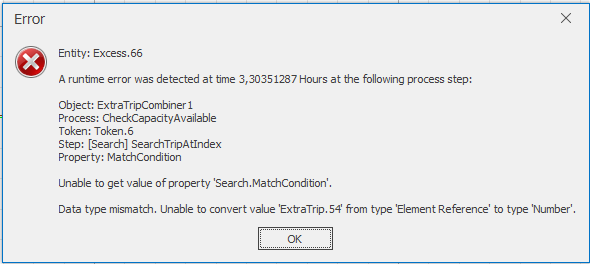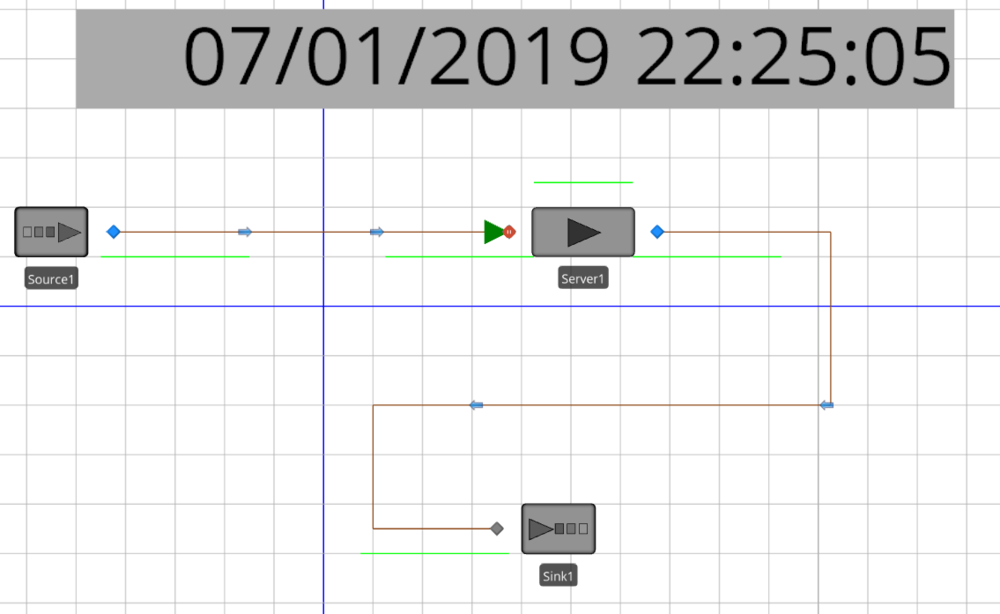Search the Community
Showing results for 'entity events'.
-
Hi, I would like to return information from an entity in a queue (parent input buffer) at a specific index. If I use the search step with following property values (see attached image) I receive an error (see attached image). What does this error exactly mean and how can I solve this problem? Thanks in advance! Christa
-

Schedule for trains - ideas are welcome -
Kaminos replied to Kaminos's topic in SI General Discussions
Thanks Jzhou, UNfortunately setting this option to True did not behave as I expected. I am using the following Arrival Table: With the timer having "Repeat Arrival Pattern" set to True The simulation runs OK until 17:15, then it starts repeating the table pattern by adding 5:15 hours ---> hence a new trigger happens at 22:15, It looks like the "Repeat Arrival Pattern" option does not take into account the date itself, but rather the time slot duration between two events. -
Thank you so much for your help. In your sample, entities choose the sink based on the sink's capacity. Which one has the lowest capacity entity is sent to that sink. In my problem, I put counter on each sink. All entities are sent to that sink until the desired value is obtained for that sink then entities go to the second sink, so on so forth. Could you please help about this problem? Thanks, Nadere
-
First, you should define a "NodeReferenceState" on ModelEntity. After finding the appropriate sink to send use "set node" step to assign the found sink's input node as the destination node of the entity (ModelEntity.NodeReferenceState=input@sinkx). Then, do not use transfer step. Instead, set the entity destination type property of source object as specific and also set node name property as ModelEntity.NodeReferenceState. By this way each entity will find its own way via the links you defined.
-
I am using transfer step for the entities to the sink but there are different links and path between the source and sink. So, if I use transfer step in add on process, the entity transfer from source to sink directly. Then, the time in system cannot be computed. I want to determine the destination (sink) by using add on process after checking some criteria. Could you please help me about this problem? My goal is to choose the sink after checking some criteria and then send entities from source to that destination(sink) by using some path randomly. Thanks, Nadere
-
Search member in batch with lowest value for state variable
gocken replied to Christa's topic in SI General Discussions
After being sure that you have at least one member entity (you can check this by using a decide step or an auxiliary expression within the search step). Then, set search steps match condition property as "Math.Min(xxx.NumberOfRollContainers)". And, place an assign step at "found" branch of search step. At this step you can change its value. -
In the batch that was created, I want to search the member entity with the lowest value for state variable "NumberOfRollContainers" and change its value to: <<TotalREQ" - 0.9 * "CapacityTrip">>, where "TotalREQ" and "CapacityTrip" are state variables of the parent entity. I am struggling with how to use the search step in this situation, so help is appreciated. Thanks in advance!
-
You can define "NodeInstanceProperty"s or a "NodeListProperty" on modelentity. If you define "NodeInstanceProperty"s on modelentity you should assign entity's sequence seperately in upper level model by assining particular sequences to each "NodeInstanceProperty". If you define a "NodeListProperty" on model entity you should assign the a list of sequences (which is previously known and exist in upper level model) to this "NodeListProperty". It seems you should define "NodeInstanceProperty"s and select appropriate servers dynamically and assign them to each "NodeInstanceProperty".
-
Hi, I have a global model state that reacts on that same timer and increments the current timeslot, that should work too, I assume? I feel that I've modelled the timeslots accurately. However, I've now run into my next hurdle: in order for the entities to make an intelligent choice on what time slots to request, first, I must be able to know what servers to visit at all. Currently, this is defined by a set of sequence tables. I have not found a way to store the sequence of destination nodes (or objects) in a (set of) states. Does anyone know how to access the sequence up front, in states or properties or lists? I'd like to store the sequence 'on' the entity, and not in the upper level model, where it has been defined. Kind regards, Tom
-
You can sum the "NumberOfRollContainers" whenever a member entity enters the combiner object by using "on member entering" property under "state assignments" section. Then, set this total to the "TotalRollContainers" state variable of the parent objet by using "before exiting" property of combiner object.
-
Hi, Is it possible to set the state variable of the parent entity in a batch equal to the sum of state variables of all member entities in the batch? Context of the case; a truck (parent) is loaded with x number of orders (members). These orders have a specific value for the state variable 'NumberOfRollContainers'. The truck has the state variable 'TotalRollContainers', which should equal the sum of the 'NumberOfRollContainers' in that batch. Kind regards, Christa
-
maybe you need to give us more details. for example, what is the entity priority lists for each vehicles..and what next load the vehicles will choose ? need a example...
-
Hello I mean each vehicle select its next load based on its unique strategy. for example, we define different entity priority lists for different each vehicles. I am trying to differentiate the behavior of the vehicles to select the next load. Regards Amin
-
Hello and thanks for reading, I'm building a model that should replicate how vessels are handled within a port area. Within this area, there are multiple Terminals (servers) and ships (entities) that have to visit any number of terminals. Their processing times at each server vary. With their sequences predefined, I have managed to model this accurately, based on a first come first serve or another dispatching rule. I'd like to implement a dynamic sequence. 1) How can I model a certain degree of freedom in their sequences - e.g. a vessel is free to choose between sequence XABZ or XBAZ, depending on the queue size at A or B at the time of leaving X? However, in reality, these vessels enter the system, draft a sequence that is suitable for their loading plan, and then try to reserve serving times at the various terminals. I have tried wrapping my head around ways to model this, but can't seem to think of a way how. I could create a large amount of state variables for each server, that denotes whether or not a certain slot has been reserved, but that is not suitable for running long simulations. I read on this forum post that I could perhaps use a storage element, and store the reservations in there. How would I go about saving reservation-related information? Should I store that on the barge entity or in the terminal's reservation storage? How should I go about modelling timeslots in itself? 2) How can I model 'future' reservations of entities at the various servers? Finally, if this functions properly, and entities can request reservations at the various servers, I would like to have the servers compare all the requests at a certain cutoff time, and for all the doubly requested slots have it allocate the reservation based on the entities' characteristics. 3) Would I have to store the reservation data on both the entity and the server side for them to both make calculations with them, or is it enough to have them all on the server side, and denote whether they have been accepted with e.g. a boolean property? My apologies for the long post. Do not hesitate to ask for more information. Kind regards, Tom
-
Dear all, I am currently working on my master's thesis. The goal is to simulate the waiting line in front of a chair lift at a ski resort. I may have future questions, so I hope we can keep this topic open for other questions on the same model. I started adding objects and need to set the properties for the servers now. Currently I am struggling to find the correct setting that allows me to process entities at a fixed time interval. I want the red barriers in front of the moving walkway to open every 7.2 seconds (interval between two chairs). The servers are called "Schranke" in my screenshot. Moreover, every barrier should open at the same time, i.e. all six servers are supposed to process one entity at the same point of time regardless of its arrival. Thanks for your help! Nico
-
In your Vehicle Properties window, those fields you have highlighted do not seem to be on my Simio version. There does not seem to be a dropdown I am missing either. Could the version of Simio have changed? Trying to do exactly this example with a piece of equipment (an entity in my model) being moved with a tug like tool that is driven by a worker. See attached for my Vehicle Properties window. Thanks, Michael
-

Event for "entity finished processing"
GFurtado replied to henrykirby's topic in SI General Discussions
Every station comes with three events: .Exited, .Entered and .CapacityChanged. So the triggering event of an entity finishing processing in a server is Server.Processing.Exited. -
Hi, I am looking for an event which can be used in a Wait step in a process which is triggered by an entity finishing processing in a station. Also potentially an event which is triggered when an entity exits a station. Do I have to manually fire an event with an addon process from every station which I wish to do this?
-
Because we assign the speed of path 3 and 5 to PathXXX.Contents.NumberWaiting at assign3 step of process 1 which is triggered whenever an entity enters node A. As I said in my previous post this expression may not serve your purposes. This is only for illustrative purposes. Here the message is you can increase all existing entities' speed (but all of them at the same time) on path 3 and path 5 whenever the process1 is triggered. Also, you can trigger process 1 by using monitor elements (which seems more suitable for your purposes). For example, using a monitor element you can track the number of entities on each path seperately and whenever this value crosses some treshold value (got congested) you can trigger process1 using monitor element. Note that in your attached model status labels shows how many enitities exist on each path. At the end, change the assignment expression of assign3 step of process1 accordingly.
-
Hi Jason, If you just want to see the emissions for each Entity traveling through your Model, you could attach a Status Label to each Entity type displaying the TotalDistanceTraveled, or some calculation including it like TotalDistanceTraveled*0.323. To attach it just click on the Entity instance in Interactive mode and then draw the Status Label near it. Or you could define State Variables like Ship_Dist, Truck_Dist, Train_Dist to keep track of total distance traveled for all Entities of each type. You would then define State Assignments at their final destination (Sink), or some Node along their path, to increment with NewValue of "Ship_Dist + ModelEntity.TotalDistanceTraveled" then compute the total emissions for each type at the end of the run. Note that you would need an Assign If 'Custom Condition' like 'ModelEntity.Is.ShipEntity' for this to work. Happy modeling, Adam
- 1 reply
-
- totaldistancetraveled
- distance
- (and 5 more)
-
As far as I know you can not accelerate the speed of an entity on any link? you should use tricky solutions to overcome this difficulty. One of the trick is setting the speed of entities to infinity right after entering node a. then changing the desired speed of path 3 and path 5 to some meaningful values. In the attached model this trick is applied. Note that the assigned values (i.e., Path3.Contents.NumberWaiting) should be replaced by any reasonable values. This assignment is only for illustrative puposes. Note that by this way we made the speed of modelentities limitless but at the same time we limit their speed with the speed of paths. you can do any other tricks as well... One of them maybe changing the type of the modelentities right after entering path 3 and path 5 (say path3_modelentities and path5_modelentities) by creating a copy of the associatedobject. Be sure to destroy the original one. And then whenever you need to increase their speed you should search their population by a search step and then assign appropriate speeds to them individually. These are the ones that come to my mind at the moment, but you can find some better methods by pondering. EntitySpeed4_me.spfx
-
Each entity running on a model is actually an instance of another model (a model entity). You'll se each individual distance travaled if you add an attached label on your ship entity, or else you'd need to reference that particular instance somehow. In the model attached in this post, I get the distance traveled of the last entity created. You also could set a "checkpoint" that assigns ModelEntity.TotalDistanceTraveled to a state whenever that entity goes through it. AttachedLabel.spfx
-
Please help, I am at a loss, I have been trying for hours now and I assume the solution to be very simple and I'm just overlooking it. I have three entities going through my system; Ship, Truck and Train. All three entities have different carbon emissions. I want to create a status label that shows the total carbon emissions per entity based on kilometers traveled in the system. The label should show something like 'ShipEntity.Totaldistancetraveled * 0.323 (or whatever co2 output is for that entity)'. However you can't set 'totaldistancetraveled' or record it with any variable for these entities, only the 'ModelEntity' that I didnt create myself but is always there when you start. Also, I don't want to use vehicles. I just want to use entities through my system. Please help me. I have attached the model for your reference, I dont know if that is necessary or if it helps. Kind regards, Jason Corridor Model 0.05.spfx
- 1 reply
-
- totaldistancetraveled
- distance
- (and 5 more)
-
Please help, I am at a loss, I have been trying for hours now and I assume the solution to be very simple and I'm just overlooking it. I have three entities going through my system; Ship, Truck and Train. All three entities have different carbon emissions. I want to create a status label that shows the total carbon emissions per entity based on kilometers traveled in the system. The label should show something like 'ShipEntity.Totaldistancetraveled * 0.323 (or whatever co2 output is for that entity)'. However you can't set 'totaldistancetraveled' or record it with any variable for these entities, only the 'ModelEntity' that I didnt create myself but is always there when you start. Also, I don't want to use vehicles. I just want to use entities through my system. Please help me. I have attached the model for your reference, I dont know if that is necessary or if it helps. Kind regards, Jason Corridor Model 0.06.spfx
-
Connecting conveyors with vehicles
JuliaGeurs replied to JuliaGeurs's topic in SI General Discussions
Thank you very much for your help, though this does not help me solve my problem, i'll try to explain it a bit better. in my model, a passenger (parent entity) arrives at a separator object with one or multiple batched entities (bags), these then separate from each other. to represent the real system, a tray should also be available to put the bag on (this should be available before the separation starts), i modelled the tray as a vehicle because then i could model the "need for the tray to be available" as a secondary resource. After the separator the tray (with bag) should move on a conveyor through the system, and at the end the tray is taken back to the beginning of the system and the bag leaves the system. so the vehicle does not take the bag to the conveyor, but rather transports the bag on the conveyor. I didn't know how to model this with the tray being represented by another type of object, therefore i choose the vehicle object. I added a simplified version of the part of my model (of the part where i have issues) here, what i would like is that when the tray/bag move through TransferNode 1 (and/or 2) that the bag(modelentity) stays on the tray (transporter). VehicleThrough.spfx








